Anise Hyssop: A Perennial Native
Agastache foeniculum
By Thea Summer Deer
Facilitator of Love Your Liver: Spring and the Wood Element
http://www.wisewomanuniversity.org/summerdeer/
Strolling one recent afternoon with my English friend, Rachel Clearfield, through her wild and magical garden, 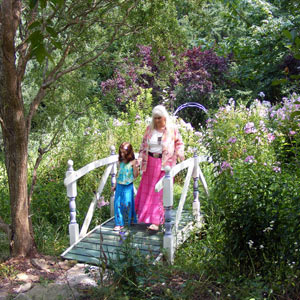 I couldn’t help but drink in the soft summer light that filtered through the weeping willows trees. There were also peach, plum, apple and apricot, all of which Rachel had planted herself. She loved sharing the abundance of this amazing garden; introducing me to exotic vegetables, and calling the various flowers and herbs by name as we made our way down the narrow paths. This garden clearly feeds her soul and is the same garden that inspires her fine “classical visionary” oil paintings for which she is so well known.
I couldn’t help but drink in the soft summer light that filtered through the weeping willows trees. There were also peach, plum, apple and apricot, all of which Rachel had planted herself. She loved sharing the abundance of this amazing garden; introducing me to exotic vegetables, and calling the various flowers and herbs by name as we made our way down the narrow paths. This garden clearly feeds her soul and is the same garden that inspires her fine “classical visionary” oil paintings for which she is so well known.
Laying my eyes for the first time on this idyllic scene I recalled one of my favorite paintings simply titled, “Rachel’s Garden. “ It graces the cover of my CD recording entitled, “My Mother’s Garden,” which also features her cellist husband, Ron Clearfield. The vision was becoming clear as we sat on the gazebo swing with Rachel pointing out the lilies she had included in the painting. Rachel’s mother was an English gardener, as was my own and we were the daughters carrying it on. And so it was through the oils of Rachel’s paints and the eyes of her vision that I first entered this paradisiacal garden nestled in an Appalachian Mountain holler.
Have you ever had the feeling that you were waking up in a dream, or that you were walking into the flat canvas of a painting that suddenly became vividly alive with color and dimension? That was how I felt standing next to Rachel on the quaint wooden bridge above the gentle stream beneath the weeping willow. I gazed out across the garden to where her dappled grey Arabian horse stood grazing in the pasture beyond. 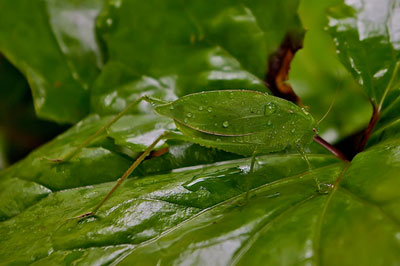 In that moment an Anglewing flew past me and landed on Rachel’s shoulder. Lesser Anglewing Katydid, Microcentrum retinerve to be exact, but Angel Wing was the word that came to mind. She didn’t notice the creature so I pointed it out to her. Personally, I believe that it was a fairie in disguise as I have seen them take on these forms before in order to be more visible to our human eye. She lightly brushed it aside.
In that moment an Anglewing flew past me and landed on Rachel’s shoulder. Lesser Anglewing Katydid, Microcentrum retinerve to be exact, but Angel Wing was the word that came to mind. She didn’t notice the creature so I pointed it out to her. Personally, I believe that it was a fairie in disguise as I have seen them take on these forms before in order to be more visible to our human eye. She lightly brushed it aside.
We continued down the garden path dropping to our knees to weed around the blooming thyme. We also took the time to stop and smell the fragrant white lilies that intoxicated us. At a particular point where the paths converged, a good distance from where we first started into the garden over the bridge, I was introduced to an herb that I had never met before. It seemed to stand out from all the rest which was notable since the competition for attention was fierce among the “Dragon’s Lingerie” string beans and colorful self-seeding poppies.
I instantly knew that this plant was Rachel’s ally and told her so. She was curious and asked how I knew this, and what medicine did it have for her. That was when I noticed the Anglewing Katydid crawling up the stem of this small and seemingly insignificant plant toward its delicate, pale purple wand of a flower. It was a sign I could not deny. Rachel pinched off a piece of the plant for me to smell and taste – and I fell in love with Anise Hyssop.
Anise Hyssop, Agastache foeniculum is in the mint family, Lamiaceae, and a perennial native to North America. 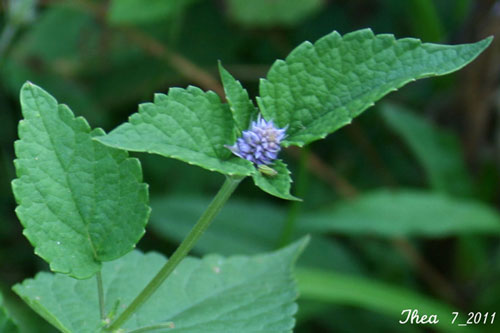 More resistant to drought than many other members of the mint family it likes to grow at the edge of open woodlands and is considered a cottage garden herb. Cultivated forms of Anise Hyssop are often grown in flower gardens and these cultivars frequently escape and establish populations in the wild. Plants that grow in their native habitat, however, and in soil for which they are designed carry the most potent medicine. More than plants that have been introduced or even naturalized, native plants embody the spirit of place. The aromatic fragrance, distinct flavor and delicate color of Anise Hyssop would make a believer out of anyone.
More resistant to drought than many other members of the mint family it likes to grow at the edge of open woodlands and is considered a cottage garden herb. Cultivated forms of Anise Hyssop are often grown in flower gardens and these cultivars frequently escape and establish populations in the wild. Plants that grow in their native habitat, however, and in soil for which they are designed carry the most potent medicine. More than plants that have been introduced or even naturalized, native plants embody the spirit of place. The aromatic fragrance, distinct flavor and delicate color of Anise Hyssop would make a believer out of anyone.
Its name derives from the Old English ysope, the Irish Latin hysopus and the Greek hyssopos. Hyssop is a word of Semitic origin that describes any of several aromatic herbs used medicinally and in purification rites and ceremonial sprinkling. It is a sacred plant used in Judaism and appears repeatedly in the Hebrew Bible. It is often used to fill the Catholic ceremonial aspergillum, a liturgical implement, which the priest dips into a bowl of holy water and sprinkles onto the congregation to bless them and to heal the sick.
An aspergillum in the form of a natural brush made from tree branches and twigs is also used by Witches at the ‘Turning of the Wheel’ to cleanse the Circle prior to seasonal rituals and to aid in creating sacred space. Pure spring water, rainwater or water charged with moonlight is used instead of Christian holy water. But really, its all the same as religious rituals are adapted down through time and are a part of our human evolution. Anise Hyssop is a blessing to any gardener.
Native Americans found many uses for this plant. They included it in their medicine bundles and burned it as incense for protection. Its uplifting fragrance was also used to treat depression. Anise Hyssop made into a poultice can be used to treat burns and in wound healing. As a wash for poison ivy it helped to reduce itching. Internally it was used to treat fevers, and diarrhea. It is antibacterial, anti-inflammatory, and very useful as an infusion for relieving congestion. As a medicinal herb it has soothing, expectorant and cough suppressant properties. A tea made from the leaves and flowers is sedating and relieves pain from coughing with chest colds. Used in combination with licorice it is especially effective for lung conditions such as bronchitis and respiratory tract infections.
The foliage of Anise Hyssop actually smells like licorice with complex notes of lemon, pine, sage, black pepper and camphor. There is no floral scent. Leaves and flowers are edible and may be baked in breads or added to salads. It is a feast for the senses and well deserving of its place in the wild garden. It attracts bees and butterflies but controls pests while encouraging pollination. Deer avoid eating this plant but rabbits love it. Hummingbirds also find it attractive and goldfinches eat its seeds. Rachel had successfully managed to incorporate various aspects of the wild garden into her own promoting biodiversity and benefitting the wider environment.
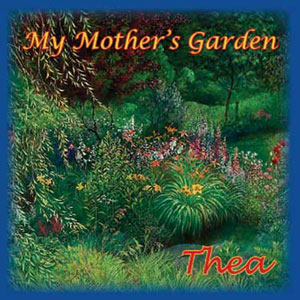 The first date that I had scheduled with Rachel to connect and spend time with her in the garden had to be rescheduled because she had a bad cough and was down with a cold. I offered to bring her some of my wildcrafted horehound syrup, but she didn’t want to expose anyone and was making teas from herbs in her garden. Her cough and cold might have been reason enough for Anise Hyssop to be a potential ally. But as Rachel and I continued meandering through her garden that day, we talked about how healing it was to be surrounded by beauty. We also discovered that we were both incest survivors. This garden that so clearly fed Rachel’s soul was also healing my own.
The first date that I had scheduled with Rachel to connect and spend time with her in the garden had to be rescheduled because she had a bad cough and was down with a cold. I offered to bring her some of my wildcrafted horehound syrup, but she didn’t want to expose anyone and was making teas from herbs in her garden. Her cough and cold might have been reason enough for Anise Hyssop to be a potential ally. But as Rachel and I continued meandering through her garden that day, we talked about how healing it was to be surrounded by beauty. We also discovered that we were both incest survivors. This garden that so clearly fed Rachel’s soul was also healing my own.
In herbal medicine a shock or trauma is said to cause what is know as a shen disturbance, or in other words – its causes the shen to flee the physical body. Shen is a concept borrowed from Chinese medicine that equates to “spirit” in Western terms. The shen is seen as residing in the heart and following shock or trauma it must be restored to the heart in order for healing to occur. The earth-spirit medicine of Anise Hyssop does exactly this, and its flower essence is said to bring back sweetness after the weight of guilt and shame, which is always unwarranted in the case of early childhood sexual abuse. Its flower essence is also used for body-soul integration of pain and suffering. It is a post-trauma stabilizer aiding the ability to forgive and to accept forgiveness.
There is no question in my mind that we were divinely guided to this sweet little plant that warm summer day in Rachel’s garden. It is clearly an ally for Rachel, but now it has also become a personal ally of my own. So if ever you happen to notice an Angel Wing (or Anglewing!) katydid lighting amongst the flowers, best not to be in a hurry or fooled by the disguise. If I were you, I’d let her be my guide.
~ ~ ~
Thea Summer Deer is a clinical herbalist in private practice in Asheville, NC. She teaches online at Wise Woman University and her class “Heal Your Heart: Summer and the Fire Element,” teaches about shen disturbances. Her book, “Wisdom of the Plant Devas: Herbal Medicine for a New Earth,” is published by Inner Traditions International, Bear & Company imprint and available from Amazon and Barnes and Noble online. Her latest CD, “My Mother’s Garden,” features 2X Grammy Winner, Mary Youngblood and celebrated cellist Ron Clearfield among other notables. It is available on ITunes and at Amazon.com. You can learn more about Thea and her music at www.theasummerdeer.com
Learn more about Rachel Clearfield’s magical realism in fine classical oil paintings at www.rachelclearfield.com
To listen to the song of the Lesser Anglewing Katydid, visit: Microcentrum retinerve
Lesser Anglewing Katydid - Microcentrum retinerve Photo by Stephen Durrenberger

WISE WOMAN UNIVERSITY ONLINE COURSES
This 12 week class will benefit herbal practitioners at any level, and individuals who want to heal their heart-mind and support their cardiovascular system for optimum health. Open enrollment.
Class description: Heal Your Heart: Summer and the Fire Element, contains information I hope will someday be taught to our children as a matter of course so they grow in the knowledge that healing takes place in the context of relationships – our relationship with each other, the earth and her seasons and with the heavens. Even our organ systems are in relationship with each other, which is eloquently illustrated through Chinese Five-Element Theory. Chinese Medicine is an empirical system of knowledge that has been in place for thousands of years. This is a class about learning how to become more present in our Heart-Mind, and how to eat and live well so that we have a healthy Heart.
Sign up for this Class
This twelve week online course,
Love Your Liver: Spring and the Wood Element, contains information I hope will someday be taught to our children as a matter of course so they grow in the knowledge that healing takes place in the context of relationships.
Thea Summer Deer - audio welcome
Sign up for this Class
About the Mentor: Thea Summer Deer is a clinical herbalist, educator, writer, and musician. She began practicing midwifery in 1978 and was a founding mother of the South Florida School of Midwifery.
Her involvement in Alternative Medicine spans 30 years as owner of Mindbody and Evolutionary Press, and as the Executive Director of Resources for World Health. She is a graduate of the Botanologos School for Herbal Studies.
Mother, grandmother, avid cook and gardener, Thea is also an award winning songwriter performing in the acoustic duo, Thea & The GreenMan.

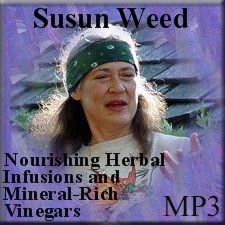
MP3 digital download - Susun Weed - Green Nations Gathering 2000. Run time 1:40:20.
Nothing improves health faster and more firmly than regular use of nourishing herbal infusions and medicinal vinegars.
Includes information on stinging nettle, oatstraw, comfrey leaf, red clover, linden, and aromatic mints.
Listen to a clip from this audio lecture by Susun Weed
Price: $14.95
Order Nourishing Herbal Infusions and Mineral-Rich Vinegars - digital download in our Bookshop
also check out the CD version
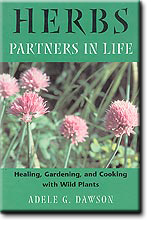 Paperback by Adele Dawson. 304 pp. Adele Dawson's classic guide to the seasonal use of herbs for food, drink, and medicine.
Paperback by Adele Dawson. 304 pp. Adele Dawson's classic guide to the seasonal use of herbs for food, drink, and medicine.
With irresistible enthusiasm and an endless store of knowledge about the plant kingdom, herbalist Adele Dawson traces the human-plant relationship through the seasons, providing practical and enlightening information about every aspect of herbalism, including spring foraging, summer gourmet gardening, the preparation of remedies in autumn, and the brewing of healing potions in winter.
The mysteries of preparing infusions, decoctions, tinctures, and essences are unraveled through the author's clear and cohesive chapters on how to identify, collect, and preserve herbs.
Detailed pen-and-ink drawings show the essential elements of flower and leaf anatomy as well as 70 wild and cultivated plants in their budding, blossoming, and dormant stages.
Sprinkled throughout the text are recipes for impromptu wild feasts such as milkweed buds tempura, directions for soothing hand lotions of marigold and milk, and an enormous variety of medicinal and culinary teas.
In equal measure an herbal encyclopedia, a health-food cookbook, and a nature guide, this book deserves a place on the reference shelf of both the new and experienced herbalist.
Price: $16.95

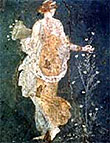
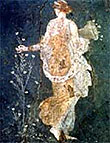
 I couldn’t help but drink in the soft summer light that filtered through the weeping willows trees.
I couldn’t help but drink in the soft summer light that filtered through the weeping willows trees. 
 More resistant to drought than many other members of the mint family it likes to grow at the edge of open woodlands and is considered a cottage garden herb. Cultivated forms of Anise Hyssop are often grown in flower gardens and these cultivars frequently escape and establish populations in the wild. Plants that grow in their native habitat, however, and in soil for which they are designed carry the most potent medicine. More than plants that have been introduced or even naturalized, native plants embody the spirit of place. The aromatic fragrance, distinct flavor and delicate color of Anise Hyssop would make a believer out of anyone.
More resistant to drought than many other members of the mint family it likes to grow at the edge of open woodlands and is considered a cottage garden herb. Cultivated forms of Anise Hyssop are often grown in flower gardens and these cultivars frequently escape and establish populations in the wild. Plants that grow in their native habitat, however, and in soil for which they are designed carry the most potent medicine. More than plants that have been introduced or even naturalized, native plants embody the spirit of place. The aromatic fragrance, distinct flavor and delicate color of Anise Hyssop would make a believer out of anyone.  The first date that I had scheduled with Rachel to connect and spend time with her in the garden had to be rescheduled because she had a bad cough and was down with a cold. I offered to bring her some of my wildcrafted horehound syrup, but she didn’t want to expose anyone and was making teas from herbs in her garden. Her cough and cold might have been reason enough for Anise Hyssop to be a potential ally. But as Rachel and I continued meandering through her garden that day, we talked about how healing it was to be surrounded by beauty. We also discovered that we were both incest survivors. This garden that so clearly fed Rachel’s soul was also healing my own.
The first date that I had scheduled with Rachel to connect and spend time with her in the garden had to be rescheduled because she had a bad cough and was down with a cold. I offered to bring her some of my wildcrafted horehound syrup, but she didn’t want to expose anyone and was making teas from herbs in her garden. Her cough and cold might have been reason enough for Anise Hyssop to be a potential ally. But as Rachel and I continued meandering through her garden that day, we talked about how healing it was to be surrounded by beauty. We also discovered that we were both incest survivors. This garden that so clearly fed Rachel’s soul was also healing my own.



